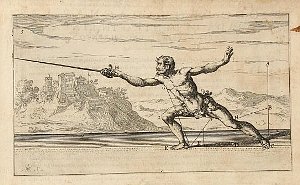 |
| Plate 23: depicting a strike from "seconda" in the chest with a "finzione" between the weapons "cavando" over the dagger. |
Ridolfo Capo Ferro da Cagli, "Gran Simulacro dell'arte e dell'uso della Scherma", 1610
Note: Access to the Capo Ferro resources is available to students and members of the Academy of European Medieval Martial Arts (AEMMA), along with complete access to Fiore dei Liberi and George Silver resources. This is particularly important for those students who are recruits training at AEMMA. It is thought that access to Liberi and Silver provided all of the basis for recruit level of training, and Capo Ferro for the Rapier training. Those individuals who have achieved scholler rank, can request access to the entire online library resource by contacting the AEMMA executive.
Very little is known about the life of Ridolfo Capo Ferro of Cagli outside of what can be found inside the pages of his fencing treatise, published first in 1610; what can be found therein is not especially edifying. The text names him as being a master of the German nation, though his city of origin,
Cagli, the city in which the text was printed, Siena, and the man to whom the text is dedicated, Federigo Feltrio della Rovere, Prince of the State of Urbino, all reside firmly within the Italian peninsula. Furthermore, Capoferro's style of rapier is clearly in the Italian tradition of fence, possessing many similarities with his fellows. In fact, his treatise is largely derivative of the other manuals at the time; his modern fame stems mainly from his work being translated into English recently, and largely undeserved acclaim as the pinnacle of Renaissance rapier by two heavily biased and deficiently informed Victorian authors, Jacopo Gelli and Edgerton Castle.

Plate 23: depicting a strike from "seconda" in the chest with a "finzione" between the weapons "cavando" over the dagger.
Historic Martial Arts Research
"From the Ground Up"
Darren Di Battista
The Treatise
This treatise has been considered in the rapier community as the pinnacle of Italian works on fencing. It is considered as one of the most comprehensive and complete written work on Italian rapier swordplay. The principles to which he details formed the basis of fencing for hundreds of years. |
| Plate 5: a figure declared by means of the alphabet, the letters highlighting the specific points of the stance in guardia. |
The next portion of the manuscript illustrates the practical applications of the basic principles described earlier, through using 43 illustrations to demonstrate the various techniques, including the martial use of rapier and dagger, rapier and shield and cloak and rapier. The illustrations clearly depict the morbid results of the fencer's inability to defend against well placed attacks.
The popularity of the manuscript through time is evidence by the fact that it has been republished many times throughout the 17th century. An edition published in 1629 had revised the illustrations by removing the existing background comprised of landscapes, castles and rolling hills with intricate artwork depicting the Old Testament. The actual figures depicting the techniques were not altered, so that the fencers may be fighting in front of a scene depicting Noah's Ark as an example.
Other Sources
Although colour images of the manuscript are not available, the following pdf files contain the manuscript in various forms: